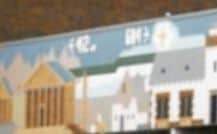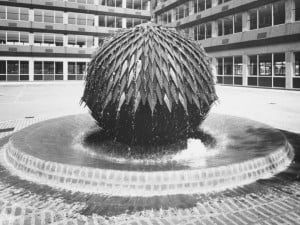
Ads help us keep this site online
What is the link between two art works with a local theme, the Pineapple and Mosaic?
It’s public art.
Historic England (formerly known as English Heritage) is campaigning to raise awareness of that mix of crime and carelessness that has led to the loss of millions of pounds worth of public art and, indeed, civic investment. Pineapple anybody?
Has it been destroyed or misplaced? Have local authorities and property owners been unaware of its location and worth? Are we just simply so familiar with public art that we only notice it most after it has disappeared?
What happened to the bronze sculpture ‘Two Forms’ by Barbara Hepworth, once on open display in Dulwich Park, or,  more locally, ‘The Pineapple’, the Corten steel water feature sculpture commissioned by Ford for their office building, Trafford House in central Basildon?
more locally, ‘The Pineapple’, the Corten steel water feature sculpture commissioned by Ford for their office building, Trafford House in central Basildon?
Public art seems to be particularly vulnerable to changes in both fashion and scrap metal values. In Basildon we saw the effects of fashion with the disappearance of ‘The Woodsman’ a sculptured carving in local oak salvaged from the ‘hurricane’ of 1987. The artist, Dave Chapple, a local man, gave the finished work to Basildon Council to look after. It remained open to the weather as it watched over St Martin’s Square.
Local anecdote has it that the statue was not liked by a particular influential councillor and no effort was made to protect it from either vandalism or rot. Eventually it was declared to be unsafe and preservation to be too costly. It was replaced by the restored globular clock that had been previously removed from Town Square during renovations.
‘The Woodsman’ is thought to be languishing somewhere in Langdon Hills having been returned to the Chapple family for restoration with the hope of its eventually going on display at a suitable indoors location.
The globular clock had a well earned reputation for its quirky timekeeping: a different time showing on each face. It has been renovated and rendered fit for purpose though its siting does not make the most of all four faces.
If you remember ‘The Pineapple’ it will be no surprise that local planners wanted it left in situ fronting Trafford House. It was a pretty impressive piece that stood over ten feet high. It needed to be a big bold statement if it was not to be overshadowed by the mass of the building behind it.
William Mitchell made the triangular leaves of ‘The Pineapple’ from rust resistant Corten corrosion resistant weathering steel that would turn a deep red when water flowed across them to drip down to the ground. Mitchell described the working fountain as looking like a giant deep-red sea anemone. Was it not insured? Replacement costs are thought to be the best part of a million pounds.
After Ford moved out, Trafford House fell to Colonnade for redevelopment, along with the shabby Laindon Shopping Centre. A pity, for the Company failed to redevelop either site and having experienced some vandalism at Trafford House decided to remove the Pineapple and store it in protective custody at the Laindon site.
Then it disappeared.
A precious work of art lost: all that remains is a fond memory.
When Pat Douglas, the Arts Correspondent for Gateway 97.8 was last in the studio, conversation turned to the Nation’s lost art works, variously lost through theft, carelessness, disregard and greed. She went home afterwards to cook a curry and, while cooking, found these lines dancing into her consciousness:
Where do all the artworks go?
We must only make sculptures from crap
Or some idiots will nick them for scrap
And the theft will incite us
To make art from detritus
Like bits of old string or a sack.
So for sculpture materials head down
To the tip where there’s loads to be found
With no cash to be made
Your work’s safely displayed
For the people all over the town.
She did explain that the curry was better than the verse!
What next — what will be the next artwork attached to a building to disappear in that speculative process known as regeneration. Perhaps the tile mural over the ‘bus station. It deserves to be kept, even if resited, out of respect for those who commissioned the piece as a symbol of their civic pride. It is part of Basildon, the New Town dream being realised.
Will it survive regeneration? Yes, if sufficient pressure is put upon those worthies responsible for giving planning permissions. It may be a difficult task, it may be cheaper to just bash it down, but if we allow such a course, we will show ourselves to be far lesser creatures than those who moved to Basildon in its early days in the belief that they could and would make it a place worth living in.
